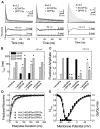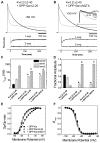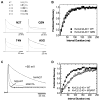A novel N-terminal motif of dipeptidyl peptidase-like proteins produces rapid inactivation of KV4.2 channels by a pore-blocking mechanism
- PMID: 19901547
- PMCID: PMC3607289
- DOI: 10.4161/chan.3.6.10216
A novel N-terminal motif of dipeptidyl peptidase-like proteins produces rapid inactivation of KV4.2 channels by a pore-blocking mechanism
Abstract
The somatodendritic subthreshold A-type K(+) current in neurons (I(SA)) depends on its kinetic and voltage-dependent properties to regulate membrane excitability, action potential repetitive firing, and signal integration. Key functional properties of the K(V)4 channel complex underlying I(SA) are determined by dipeptidyl peptidase-like proteins known as dipeptidyl peptidase 6 (DPP6) and dipeptidyl peptidase 10 (DPP10). Among the multiple known DPP10 isoforms with alternative N-terminal sequences, DPP10a confers exceptionally fast inactivation to K(V)4.2 channels. To elucidate the molecular basis of this fast inactivation, we investigated the structure-function relationship of the DPP10a N-terminal region and its interaction with the K(V)4.2 channel. Here, we show that DPP10a shares a conserved N-terminal sequence (MNQTA) with DPP6a (aka DPP6-E), which also induces fast inactivation. Deletion of the NQTA sequence in DPP10a eliminates this dramatic fast inactivation, and perfusion of MNQTA peptide to the cytoplasmic face of inside-out patches inhibits the K(V)4.2 current. DPP10a-induced fast inactivation exhibits competitive interactions with internally applied tetraethylammonium (TEA), and elevating the external K(+) concentration accelerates recovery from DPP10a-mediated fast inactivation. These results suggest that fast inactivation induced by DPP10a or DPP6a is mediated by a common N-terminal inactivation motif via a pore-blocking mechanism. This mechanism may offer an attractive target for novel pharmacological interventions directed at impairing I(SA) inactivation and reducing neuronal excitability.
Figures










Similar articles
-
S-glutathionylation of an auxiliary subunit confers redox sensitivity to Kv4 channel inactivation.PLoS One. 2014 Mar 27;9(3):e93315. doi: 10.1371/journal.pone.0093315. eCollection 2014. PLoS One. 2014. PMID: 24675763 Free PMC article.
-
DPP10 splice variants are localized in distinct neuronal populations and act to differentially regulate the inactivation properties of Kv4-based ion channels.Mol Cell Neurosci. 2007 Aug;35(4):604-24. doi: 10.1016/j.mcn.2007.03.008. Epub 2007 Mar 23. Mol Cell Neurosci. 2007. PMID: 17475505 Free PMC article.
-
Incorporation of DPP6a and DPP6K variants in ternary Kv4 channel complex reconstitutes properties of A-type K current in rat cerebellar granule cells.PLoS One. 2012;7(6):e38205. doi: 10.1371/journal.pone.0038205. Epub 2012 Jun 4. PLoS One. 2012. PMID: 22675523 Free PMC article.
-
Molecular physiology and modulation of somatodendritic A-type potassium channels.Mol Cell Neurosci. 2004 Dec;27(4):343-69. doi: 10.1016/j.mcn.2004.06.011. Mol Cell Neurosci. 2004. PMID: 15555915 Review.
-
Neuronal Roles of the Multifunctional Protein Dipeptidyl Peptidase-like 6 (DPP6).Int J Mol Sci. 2022 Aug 16;23(16):9184. doi: 10.3390/ijms23169184. Int J Mol Sci. 2022. PMID: 36012450 Free PMC article. Review.
Cited by
-
Dipeptidyl peptidase-like protein 6 is required for normal electrophysiological properties of cerebellar granule cells.J Neurosci. 2010 Jun 23;30(25):8551-65. doi: 10.1523/JNEUROSCI.5489-09.2010. J Neurosci. 2010. PMID: 20573902 Free PMC article.
-
Update on the implication of potassium channels in autism: K(+) channelautism spectrum disorder.Front Cell Neurosci. 2015 Mar 2;9:34. doi: 10.3389/fncel.2015.00034. eCollection 2015. Front Cell Neurosci. 2015. PMID: 25784856 Free PMC article. Review.
-
Peripheral Voltage-Gated Cation Channels in Neuropathic Pain and Their Potential as Therapeutic Targets.Front Pain Res (Lausanne). 2021 Dec 13;2:750583. doi: 10.3389/fpain.2021.750583. eCollection 2021. Front Pain Res (Lausanne). 2021. PMID: 35295464 Free PMC article. Review.
-
Hypertensive APOL1 risk allele carriers demonstrate greater blood pressure reduction with angiotensin receptor blockade compared to low risk carriers.PLoS One. 2019 Sep 18;14(9):e0221957. doi: 10.1371/journal.pone.0221957. eCollection 2019. PLoS One. 2019. PMID: 31532792 Free PMC article.
-
Modeling-independent elucidation of inactivation pathways in recombinant and native A-type Kv channels.J Gen Physiol. 2012 Nov;140(5):513-27. doi: 10.1085/jgp.201210869. J Gen Physiol. 2012. PMID: 23109714 Free PMC article.
References
-
- Jerng HH, Pfaffinger PJ, Covarrubias M. Molecular physiology and modulation of somatodendritic A-type potassium channels. Mol Cell Neurosci. 2004;27:343–369. - PubMed
-
- Birnbaum SG, Varga AW, Yuan LL, Anderson AE, Sweatt JD, Schrader LA. Structure and function of Kv4-family transient potassium channels. Physiol Rev. 2004;84:803–833. - PubMed
-
- An WF, Bowlby MR, Betty M, Cao J, Ling HP, Mendoza G, Hinson JW, Mattsson KI, Strassle BW, Trimmer JS, Rhodes KJ. Modulation of A-type potassium channels by a family of calcium sensors. Nature. 2000;403:553–556. - PubMed
Publication types
MeSH terms
Substances
Grants and funding
LinkOut - more resources
Full Text Sources
Molecular Biology Databases
